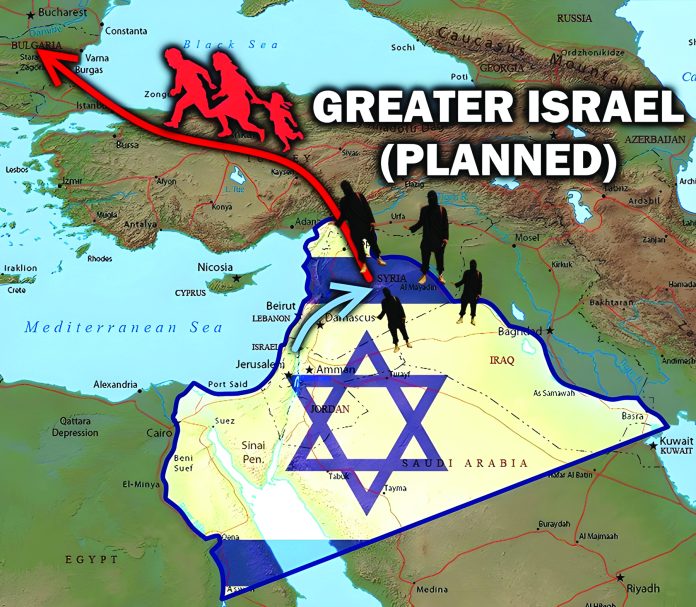Nusrat Mirza
The Greater Israel Plan, also referred to as the Yinon Plan, the Col. Peter Ralph Plan, or the Joe Biden Plan, represents a longstanding and contentious blueprint for reshaping the geography and political landscape of the Middle East. Originating in 1983 under the vision of Israeli diplomat Oded Yinon, this plan aims to create a religious state akin to the Vatican. However, its implications extend far beyond religious significance, targeting the disintegration of existing nations and the redistribution of territories to align with specific strategic objectives.
The core objectives of the Greater Israel Plan
The Greater Israel Plan aims to establish a robust and strategically advantageous state. According to the plan, this would involve reshaping borders and redistributing territories in the Middle East.
Central to this vision is creating a Vatican-style Islamic state encompassing Makkah and Madinah, which would be governed by representatives from all Islamic sects rather than controlled by the Saudi royal family. This reorganization seeks to weaken centralized Saudi power, making the region politically and militarily less potent. Additionally, the Khaybar area in Saudi Arabia is proposed to be handed over to Jordan, while the eastern provinces of Al Ahsa and Qatif, known for their significant Shia populations, are suggested to be annexed to Syria. This would fragment Saudi Arabia’s territorial integrity and diminish its regional influence.
The Ahwaz region in Iran, home to an Arabic-speaking majority, is also envisioned to become part of Iraq. Meanwhile, the Kurds spread across Saudi Arabia, Syria, Turkey, Iraq, Iran, and Azerbaijan would be unified into a single Kurdish state. This unification aligns with the historical admiration for Salahuddin Ayyubi, a Kurdish leader respected in Jewish history for protecting Jewish communities.
Geopolitical implications
The Greater Israel Plan’s scope is not confined to territorial adjustments. It extends to creating new political and economic corridors that could fundamentally alter the region’s dynamics. For instance, a plan is to construct a canal through Gaza, reducing dependency on the Suez Canal and undermining Egypt’s strategic importance. Israel’s ongoing occupation of the Golan Heights is another step towards controlling key areas such as Damascus and securing access to Lebanon via Beirut. This would provide Israel with a direct maritime route and greater regional leverage.
Iran stands as a critical target in this plan. Once considered a formidable opponent, Iran’s position has weakened significantly due to extensive espionage activities and the loss of key figures like Hezbollah’s Hassan Nasrallah. This vulnerability has paved the way for more aggressive strategies to fragment Iran into smaller, weaker states. The regions of Sistan and parts of Pakistan’s Balochistan are particularly at risk, with the envisioned creation of a new entity called Greater Balochistan.
The threat to Pakistan
Pakistan, already grappling with internal strife and institutional challenges, is a crucial piece in this geopolitical puzzle. If any part of Pakistan comes under this plan, the instability within its borders will make it susceptible to external interventions.
Historical context and current developments
The Greater Israel Plan has deep roots, but its contemporary manifestations have gained momentum. The Sixth Arab-Israeli War in 2006, a 33-day conflict that ended with Hezbollah technically outmaneuvering Israel, marked a significant moment in regional resistance. However, the current geopolitical landscape is starkly different. Israel’s objectives appear to be advancing, facilitated by shifting alliances and the weakened state of its adversaries.
President Joe Biden’s administration has accelerated these efforts. His declaration of being an “Irish Zionist” underscores an ideological commitment to these plans. Recent events, including the October 7th attack, have consolidated Israeli Prime Minister Netanyahu’s power, silencing opposition and providing a pretext for further aggressive actions. The occupation of the Golan Heights and the increasing encroachments on Syria and Lebanon signify a strategic buildup for the next phase of this plan.
The need for a unified front
The ramifications of the Greater Israel Plan extend beyond the immediate region, threatening to destabilize neighboring countries like Iran, Turkey, and Pakistan. Without a coordinated response, these nations risk fragmentation and loss of sovereignty. A united front involving Iran, Pakistan, and Turkey is imperative to counter this threat. Such an alliance could serve as a bulwark against the disintegration of these states and the realization of the Greater Israel Plan.
A long-term vision
The Greater Israel Plan is not a short-term strategy but a long-term vision aiming to reshape the Middle East over decades. Even if the current efforts do not fully succeed, history suggests that the plan’s proponents will persist. Iran’s strategic weakening and the internal challenges facing Pakistan and other regional powers create an environment conducive to the plan’s gradual implementation.
Conclusion
The Greater Israel Plan represents a complex and multi-faceted strategy with profound implications for the Middle East. It seeks to redraw borders, create new states, and weaken existing powers to establish a dominant regional order favorable to Israel. The urgency for regional powers like Iran, Pakistan, and Turkey to unite cannot be overstated. Failure to act decisively risks their territorial integrity and the broader stability of the Middle East. As history unfolds, the trajectory of this plan serves as a stark reminder of the enduring need for vigilance, unity, and resistance in the face of such grand designs.
The author is the Chief Editor of the monthly Interaction.







